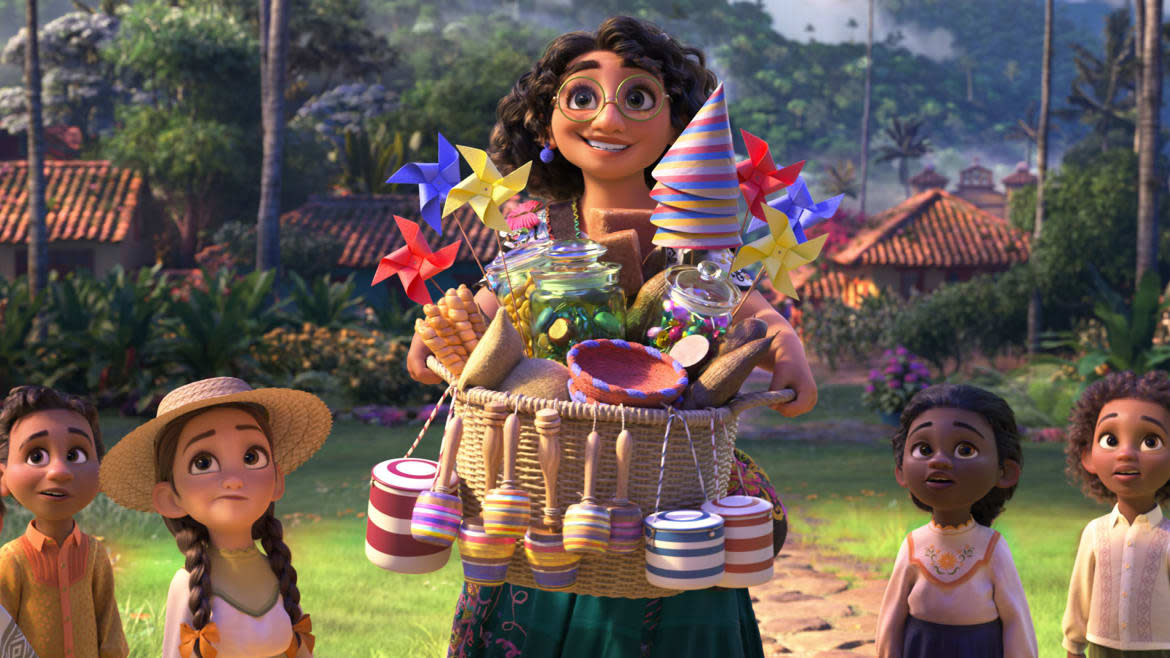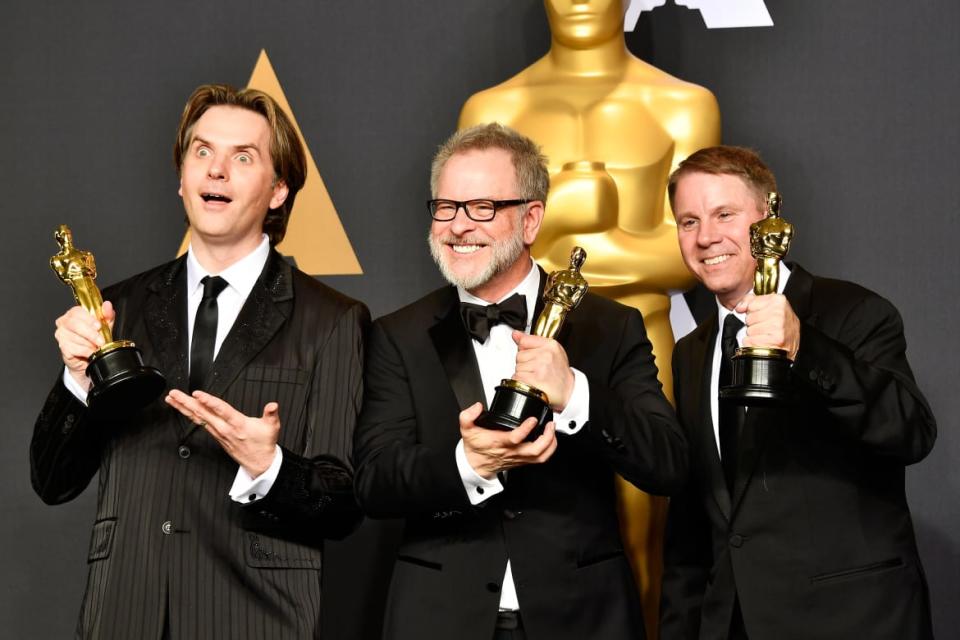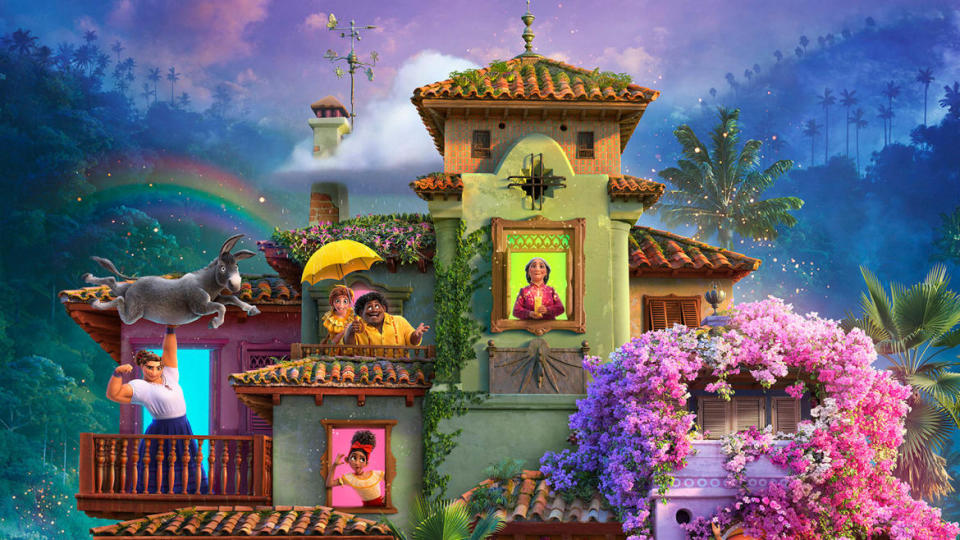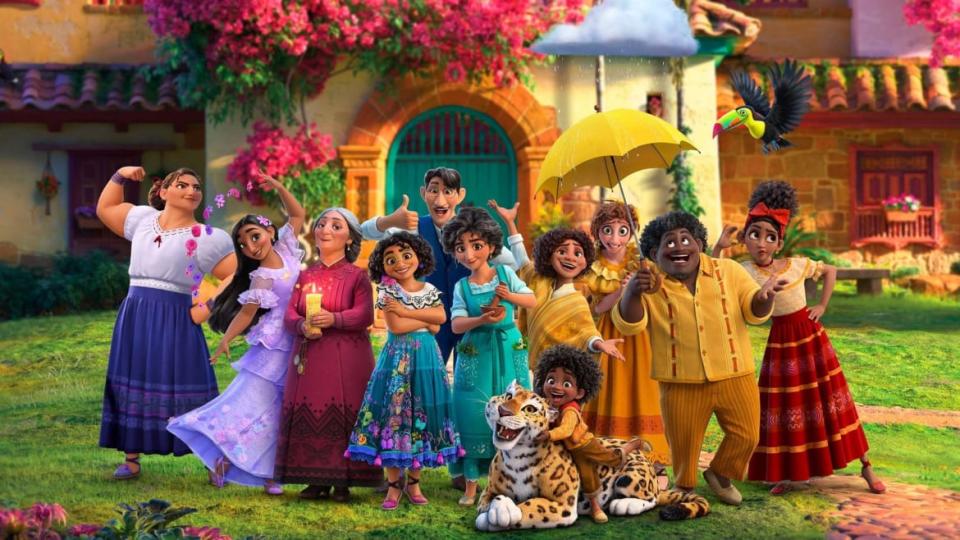The Secrets of ‘Encanto,’ the Magical New Disney Film Celebrating Colombian Culture

- Oops!Something went wrong.Please try again later.
- Oops!Something went wrong.Please try again later.
- Oops!Something went wrong.Please try again later.
Encanto, the new film from Walt Disney Animation Studios, is bursting with magic.
That much was clear from the approximately 30 minutes of footage that was previewed at the SCAD Savannah Film Festival last week, including about 15 minutes of its rousing opening musical sequence, another memorable song written by Lin-Manuel Miranda, and a tease of the scene that begins to reveal the dark secret that drives the film’s narrative.
Bursting with magic, however, isn’t just a wink at the Disney tradition. Magic itself is at the heart of Encanto, which hits theaters Nov. 24, just in time for Thanksgiving. Set in Colombia, the film takes place largely within the confines of a family house that was built on what the culture reveres as a place of magic, an encanto.
Don’t think of European wizards, wands, or enchanted objects, in the way that we might be familiar with after generations of Disney films—though a living, breathing, fantastical house is a centerpiece.
The idea of encantos in Colombia ties magic to emotion, in the tradition of magical realism. If you’re familiar with the work of Latin writers like María Luisa Bombal or the Colombian-born Gabriel García Márquez, then you have a sense of the spirit that cascades through the film—a real-world setting in which the magical or supernatural exists and is accepted alongside the mundane.
At the start of Encanto, through a lively musical number pulsing with Latin flair, we’re introduced to the Madrigal family. As explained through song by 15-year-old Mirabel (voiced by Stephanie Beatriz), each member of the generation-spanning clan is gifted. Luisa (Jessica Darrow) has superhuman strength. Tía Pepa (Carolina Gaitan) controls the weather with her emotions.
The Bizarre Buzz Lightyear Political Controversy Making People Lose Their Minds
When a new child in the family comes of age, they are guided by Abuela Alma (María Cecilia Botero) to the door that will bestow on them their unique gift. The footage unveiled in Savannah included the stunning sequence in which young cousin Antonio (Ravi Cabot-Conyers) receives his: the ability to talk with animals.
The Madrigal house and the hamlet in its orbit is an enthralling fantasia. As shown in that teaser footage, flowers bloom on the whim of a sister, Isabela (Diane), whose gift is to make the world prettier. Luisa can move mountains, literally, to help out the townspeople. Rain and sunshine come and go according to mood. Animals and humans commune thanks to Antonio, and the house, as much a character and member of the family as any Madrigal, is in constant movement, transforming itself in conversation with the emotional needs of family.
It’s vibrancy at its most vivacious—a kaleidoscope of color, music, and élan all rooted in the diverse tenets of Colombian culture, where nothing is a monolith and a plethora of experiences beg for representation.
That there’s such striking beauty, joy, and, yes, magic all around her makes Mirabel’s reality all the more crushing. She is the only member of the Madrigal family without a gift. Amid a constellation of extraordinary relatives, she is not special. How does a person in such a circumstance and in such a family find a purpose, discover her worth, and learn to thrive?
But as buoyant and as exuberant as things seem in the magical Madrigal estate, there are cracks—actual cracks, threatening the foundation of the house—that only Mirabel seems to have the keen eye to see. It leads her down a path exploring what had happened to her mysterious estranged Tío Bruno (John Leguizamo), the family secrets that no one will talk about, and what is at stake if they’re revealed—or, perhaps even worse, stay buried.

(L-R) Co-directors Byron Howard and Rich Moore and producer Clark Spencer, winners of the Best Animated Feature Film award for Zootopia, pose in the press room during the 89th Annual Academy Awards at Hollywood & Highland Center on February 26, 2017, in Hollywood, California.
“What our film is trying to say is that you’re only getting this sliver of understanding of the people closest to you,” writer and director Jared Bush tells The Daily Beast. “You have to ask those questions. And at the same time, when asked those questions, you have to be vulnerable enough to be able to answer them.”
Bush and co-director Byron Howard had previously worked together on Zootopia, the Oscar-winning animated feature from 2016 about an underestimated rookie bunny police officer who works to uncover, against odds and expectations, a massive conspiracy. Their goal was to evolve and add depth of character to the idea of what a “talking animal” movie could be. Both lifelong musicians, they next wanted to apply those same principles to the tradition of animated musicals.
Bush had previously worked with Lin-Manuel Miranda on Moana. The multi-hyphenate creator had come to him and Howard with the lofty, yet vague desire to do a Latin American musical for Disney. What followed was a five-year collaboration rooted in family exploration, cultural community-building, and copious research.
Once they arrived at the idea of setting the film in Colombia, a place renowned as the crossroads for the diversity of Latin culture, the trio, along with Miranda’s father, Luis, traveled to Colombia to soak in the sense of place. After that experience, they operated from a position in which authenticity would be key.
When Encanto premieres, it may rank as the most monumental effort from Disney to celebrate cultural authenticity, rooted firmly in the Colombian experience. It’s also arriving at a time when demands for inclusivity aren’t just louder than ever, but scrutiny over whether it’s done right is harsher, too.
The team hired Charise Castro Smith, who is Cuban-American, to work with them on the script and serve as co-director. Early on in the process, before Colombia was even officially the setting of the film, Bush and Howard assembled what they referred to as the “Familia.” These were lunchtime gatherings that took place often over the years of production and were born out of an open invite to Disney Animation employees to discuss their families and relationships, which became incredibly valuable as members whose families are from different parts of Latin America weighed in.
Another resource was what they called the Colombian Cultural Trust—a collection of journalists, architects, musicians, artists, documentarians, and even botanists who advised on the authenticity of everything: accents, skin color, the music, the magical realism, house design, wardrobe, and more intimate things, like how family members might talk to each other, what they might eat, and details down to how Mirabel’s curls might fall.
After presenting the exclusive footage to those gathered at the Savannah Film Festival, Bush sat down with The Daily Beast to preview more of the film.
Encanto is Disney Animation’s 60th title, but, as a milestone, it’s significant beyond a number. The level of cultural representation is historic, and its message about family runs deeper than some might expect from the studio. Bush talks about the pressures of getting it right and why, he hopes, in addition to being swept away by the glorious Colombian culture celebrated, Encanto might serve as a little bit of family therapy for all of us.
I’m really interested in the inception of the “Familia” group that was recruited from across the company. That’s obviously not a normal practice for a studio like this. What was the sell you used to recruit this group?
Knowing that we wanted to start with families, we really just said, “Okay, who wants to come and talk about the families?” And it was a lot of people. But we also wanted to hear family through a Latine, Latinx lens, which is really important. What we found was that there’s this unbelievable universality that everyone had with their families. I think early on, for a lot of us, we realized that a lot of times in the past, Disney may have talked about family as “it’s always going to be great.” And we said, yes, it is great. But what are the more complex, difficult things to talk about? And how can this movie do that?

You said during your presentation that the starting point for all of this research was looking into your family and digging into the things that you hadn’t known about them.
I was blown away, actually. My father is somewhat of a historian and has pages and pages—like hundreds, thousands of pages—of family history. I was originally thinking, “What am I gonna learn about my family from 100 years ago?” What I did not expect was to find out about my family now.
What did you learn about your family now?
One of the pivotal conversations that actually changed things a lot and really informed this movie was when I was talking to my sister. My older sister, in college, was an amazing athlete, a gymnast… like crazy amazing. She also wanted to be an artist. And I was saying to her that I was so thankful that our parents let me move from Maryland to Los Angeles with no plan, that they would just say, “Go follow your dreams.” And she was like, “Yeah, that’s not what mom and dad did for me.” I realized, as the oldest child, she was sort of a guinea pig of what I got, and that her experience growing up was very different from mine. It had never occurred to me. I was in my forties when I realized just how different our childhoods had been. That literally blew my mind.
Did you unearth any other secrets, like Mirabel does in the film?
I learned stories about my grandmother on my mom’s side and how she grew up. They were stories where it feels like you’re reading something from someone else’s family. There was a story about someone who maybe they thought he either died or disappeared or got taken to witness custody. I was like, what is happening? But it was all right there. I just never thought to ask those questions, which is what our film is trying to do—you’re getting this sliver of understanding of the people closest to you. You have to ask those questions. And at the same time, when asked those questions, you have to be vulnerable enough to be able to answer them.
I haven’t seen the full film, but I have to imagine themes might center around how, yes, it’s scary to find out the darker, more uncomfortable parts about your family. But maybe it’s actually healing, too.
Oh, yeah. I’d say that for this movie. Something we definitely want to talk about was, yes, some of those things are really hard. But it gives you an unbelievable window into the people that you love, and an amazing amount of empathy. I think, honestly, so many of us don’t show ourselves fully out of fear, or because it’s uncomfortable, or yo’'re just worried that you’ll be judged. You’re holding all of these things, but those things really are actually what define you a lot of the time. Yet you just don’t share it.
In so many Disney animated films, especially ones that have young girls as protagonists—typically young princesses—the point of the story is the thing that makes them special, or odd, or magical. It’s almost subversive in this case for Mirabel’s thing to be that she isn’t special, at least not in the eyes of those around her.
Something I can really relate to no matter where I am, but definitely at Disney Animation, is that I constantly feel like I’m surrounded by all these extraordinary superheroes and I don’t feel like I measure up. That’s something we talked about a lot early on and realized, oh, I think everybody feels that way. I think that’s more the default. More than “I am awesome” and “I’m king of the world” is like, “I think all these other people have it figured out, and I don’t.” Certainly with social media, that’s how it is. So I think having a character that could be us, that could really be the flawed, imperfect, ordinary one amongst the extraordinary really felt like something relatable. All of our movies are our therapy to some extent, and that’s what this was for me.
Especially in 2021, when something like this comes out from Disney, it puts a major spotlight on the efforts toward authenticity and cultural representation—and accuracy. I’m curious to hear more about the formation of the Colombian Cultural Trust. What concerns or anxieties did you have, perhaps especially as a white creator, when it came to making sure this was done right?
Well, they were big. I think what a lot of people don’t know is we didn’t start thinking that we were going to set this movie in Colombia. When Byron and Lin and I first started, Lin just said, “I want to do a Latin American musical for Disney.” That’s all we had. That could have been set anywhere. But we needed to find a place that felt like a real location. We didn’t want to invent a fantasy location. We wanted somewhere where naturally you’d have all these different people. We wanted to find a place where we felt like we could bring as many different types of people, ethnicities, cultures, music, art, everything, and it would feel organic. And Colombia kept on coming up as the place to do it.
And from there, I guess, began a five-year crash course in learning about Colombia and Colombian culture?
That’s why it was so important to have both the “Familia” group and the Colombian Cultural Trust. I think a lot of people believe that those groups come in and basically tell us what we’re not doing right. It’s actually not that. We’re all in it together, trying to build something as a group. So I think it was about having an immense amount of trust with everyone so that anyone can say whatever they want and, even more importantly, can bring new things to the table. It’s not just saying, “Oh, that shouldn’t look like that. That should look like this.” It was, “Have you considered doing this? Because this would feel really good, or might really, really resonate.”
The Dazzling ‘In the Heights’ May Be the Best Movie Musical in Decades
At what point did the concept of encantos enter the mix as something to develop this narrative around?
I have to give credit to the “Familia” group. That came from that group we talked about. We were really excited about magical realism, and we obviously read a lot of those works. But in one of our “Familia” groups, one member talked about a book that referenced some of these pueblos mágicos, which are what are sometimes called magical towns. They’ve been sort of spiritual places forever. She said they call them encantos. She showed it to us in the book. Byron and I looked at each other and were like, that’s the name of the movie. That’s what it is right there. That could have only happened from that group.
Is that when the idea that the house would be magical and a main character came about?
I want to say we had a magical house earlier than that. But I do remember we were at a museum in Long Beach doing research, called MOLAA, the Museum of Latin American Art. This was early on. We didn’t have magic in the movie yet. I remember seeing a picture of Frida Kahlo. It was one of the few color pictures they had. She was standing next to two deer. There was something about the way that she was standing with them, and the way they’re interacting with her, like she had this connection with animals and could actually communicate with them. I was like, oh, wait a minute. Maybe our characters can have magic. We knew we were going to have family archetypes. Maybe we could flush them out and make them something a little bit more fantastical.

One thing people are already picking up on just from watching the trailer is that the characters have a variety of skin colors. There are dark-skinned Afro-Latino characters prominently featured. Following the recent backlash Lin-Manuel Miranda received for not featuring Black Latinx characters prominently in In the Heights, people seem to be grateful for that.
That was critical, and something that we talked about with the “Familia” group from the beginning. That’s something we heard constantly, that there’s a huge, wide range. If you’re going to tell a story about a family, bring as many of those people into the story as you possibly can. Especially in Colombia, but in the Latin community itself, it’s a very wide spectrum, and that’s something that we haven’t always put on screen. That was important to us.
What did you learn from the process of making Moana and the power, but also the responsibility, of putting on screen characters that are from backgrounds, cultures, and with skin tones that hadn’t been seen before on a Disney scale?
Widening your perspective is critical and makes the movie better. I think that the trickiest thing is not relying on what is intellectually correct, and more what feels right. Like, in your bones correct. Those are very different things. That was really important for this movie.
Finally, what does this movie mean to you?
I think a lot of us need to understand our families better. Family could be your actual family. It could be your friends. It could be your community. I think, as people, we don’t really see each other all the time. So I’m hoping that people will see this and want to ask questions. That’s really important to me. For Mirabel’s journey, specifically, a character who feels ordinary amongst all these extraordinary members of her family, that really hits home for me. I hope that people realize not only are they special and unique and extraordinary for different reasons, but I hope they will see that the person across the way who looks like they got it all together probably doesn’t either. They’re also going through their own struggles. I’m hoping that people will consider thinking about that, ask them these questions, or give them a break. Try to at least understand and realize that you’re only seeing this tiny, little piece of somebody. If we could see more, it’s a way for us all to connect better and try to understand each other better.
Get our top stories in your inbox every day. Sign up now!
Daily Beast Membership: Beast Inside goes deeper on the stories that matter to you. Learn more.

